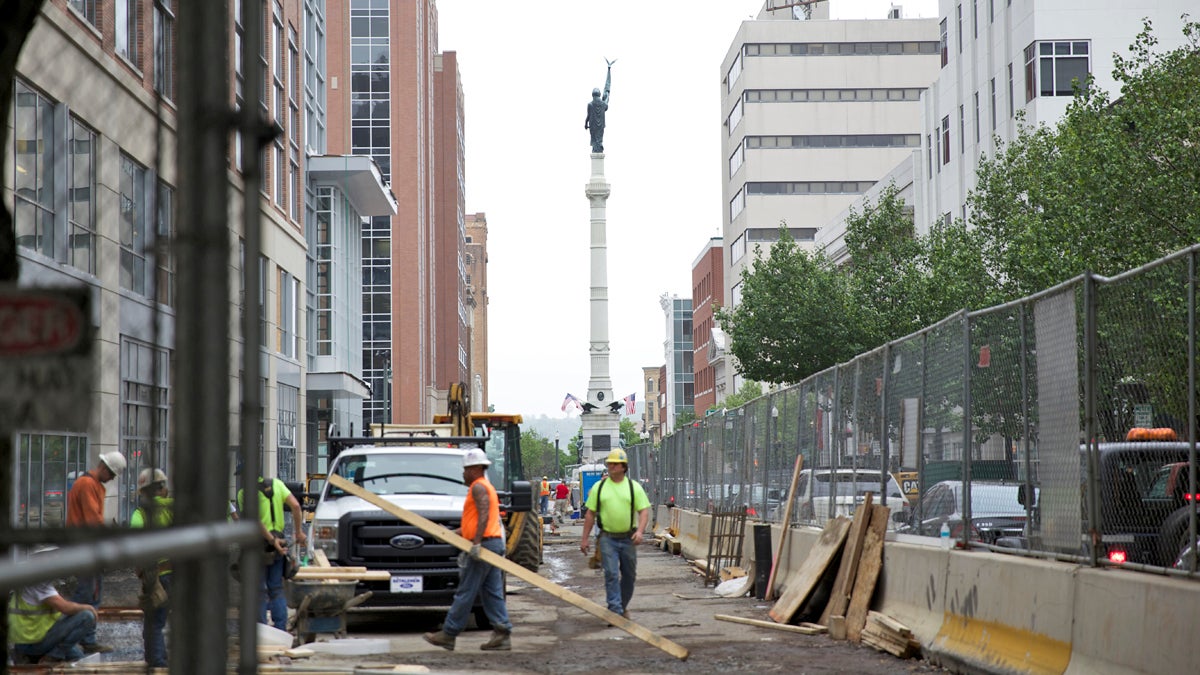What is a Neighborhood Improvement Zone?

Construction workers build the new PPL Center on Hamilton Street in downtown Allentown. The city’s new hockey arena opened in September 2014. (Lindsay Lazarski/WHYY)
One in a series explaining key terms and concepts of Pennsylvania government. Today’s topic: the Neighborhood Improvement Zone.
Seeking a better understanding of Pennsylvania’s issues and proposed solutions? Sometimes, complicated jargon and concepts can get in the way. That’s why we started Explainers, a series that tries to lay out key facts, clarify concepts and demystify jargon. Today’s topic: the Neighborhood Improvement Zone.
The opening of Allentown’s new hockey arena has spurred a lot of talk about the city’s Neighborhood Improvement Zone (NIZ) program. It’s a state tax incentive program that’s helping the struggling city reinvent its downtown.
The Pennsylvania legislature passed a law establishing the NIZ in 2009. A state senator from the Lehigh Valley wrote the legislation specifically for Allentown, and it’s the only city that qualifies.
Allentown Mayor Ed Pawlowski says the NIZ allows the city to “capture some of [its] fair share” of state tax revenue. “Think about the billions of dollars that have gone into Pittsburgh and Philadelphia over the course of the last ten years,” Pawlowski said. “Allentown is the third largest city [in the state] and has gotten a pittance of those state dollars to help build out these types of facilities and infrastructure.”
What the NIZ does
The NIZ allows developers in certain parts of Allentown to use state and local tax dollars to construct and rehabilitate buildings. These tax dollars are paid by businesses that move into the developers’ new buildings.
Instead of keeping that tax money, the government is giving it to the developers so they can pay off their debt. That’s a sweet deal, and it’s having the intended effect: attracting developers downtown. Those developers are saving money, so they can lure more businesses downtown by offering lower rents than buildings in other areas.
As part of this project, the city of Allentown has gotten a brand new $200 million arena called PPL Center, home to the Philadelphia Flyers’ top minor league hockey team, the Lehigh Valley Phantoms.
The arena is also financed using tax dollars, including about $22 million a year paid by businesses that have been in the neighborhood since before the NIZ existed. That means tax dollars that were once going to the city and state are now helping to bankroll Allentown’s arena.
Most of the tax revenue is coming from state coffers.
Here, we explain how the NIZ works and how it could benefit the state.
What is the NIZ?
The Neighborhood Improvement Zone is an area of Allentown where developers can use state and local tax dollars to pay off the debt they incur to build, rehabilitate or expand buildings. The zone is tiny — about one fifth of a square mile.
The zone is broken up into a few pieces. One is a five-block area in Allentown’s downtown that includes the city’s new hockey arena, PPL Center. The city estimates that the arena will bring one million visitors to Allentown a year. Advocates say the arena is different from other publicly subsidized sports venues. But some worry it will raise property values and push locals out of their homes.
Another piece is on Allentown’s waterfront, where local developers are turning former industrial land into office buildings and apartments. Brewing company Ruckus, for example, is revitalizing the former Neuweiler Brewery, which hasn’t operated since 1968.
The NIZ will be in effect for 30 years.
Which tax revenue can be used to fund projects in the NIZ?Most state and local taxes paid in the zone, including taxes on personal and corporate income, cigarettes, malt beverages and liquor, and sales of construction materials. Property taxes cannot be used.
The lion’s share of this money — more than 97 percent — is state tax revenue.
That means the state, far more than the city, is subsidizing Allentown’s revitalization.
Why is Allentown getting this tax incentive program?
Like other Pennsylvania cities, Allentown has been struggling for a long time. It used to be a retail hub, with big department stores like Hess’, Leh’s, and Zollinger’s. But in the 1990s those stores shut down as suburban malls drew business out of the city. Poverty increased downtown. Today, half of downtown residents live below the poverty line and unemployment is nearly twice the state average.
State Senator Pat Browne (R – Lehigh) wanted to turn the city around. He came up with a unique plan to bring developers back downtown, and he lobbied for it in the state legislature. In 2009, the state passed Act 50 establishing the NIZ. The state amended the law in 2011 and 2012. The way the law is written, only Allentown qualifies for the zone.
Local officials hope the zone can attract developers and new businesses, create jobs, and make downtown Allentown a destination.
State legislators agreed to this plan because they think the state will benefit in the end.
Can my city get a NIZ?No. The way the legislation was written, only Allentown qualifies.
But the state created another program, the Community Revitalization & Improvement Zone (CRIZ), based on Allentown’s NIZ. Bethlehem and Lancaster were the first cities chosen to participate.
Read about how the NIZ and CRIZ compare, and whether your city might be the next to land a CRIZ.
Did this article answer all your questions about the Neighborhood Improvement Zone? If not, you can reach Marielle Segarra via email at msegarra@whyy.org or through social media @MarielleSegarra. Have a topic on which you’d like us to do an Explainer? Let us know in the comment section below, or on Twitter @PaCrossroads.
WHYY is your source for fact-based, in-depth journalism and information. As a nonprofit organization, we rely on financial support from readers like you. Please give today.


